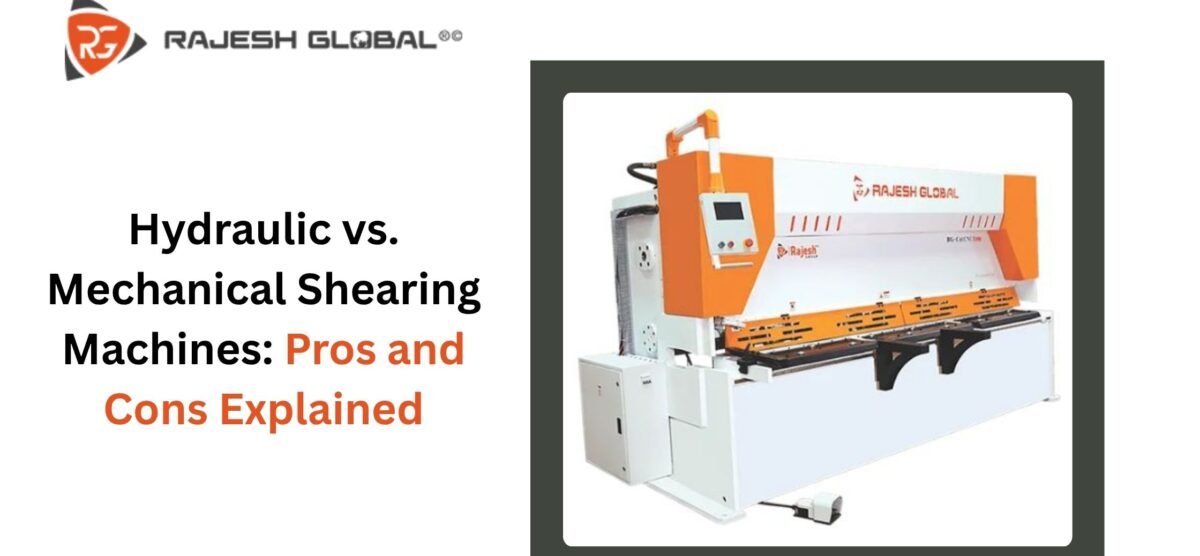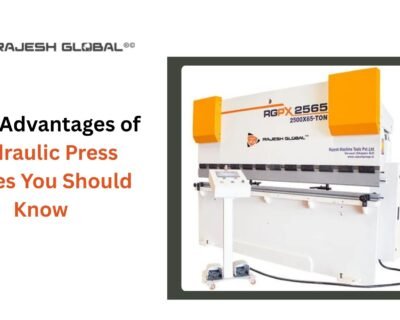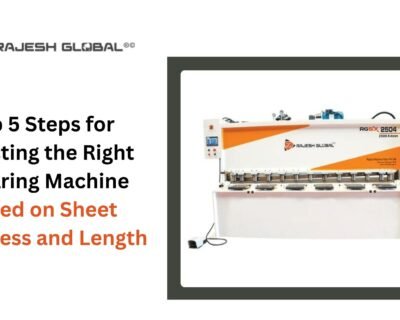Blog

Hydraulic vs. Mechanical Shearing Machines: Pros and Cons Explained
The global market size for metal shearing machines was valued at approximately USD 3.5 billion in 2023, yet here’s the uncomfortable truth nobody talks about: 60% of manufacturers are choosing the wrong technology for their applications. They’re making decisions based on upfront cost rather than operational mathematics.
The hydraulic versus mechanical debate isn’t just about cutting metal—it’s about understanding which physics will dominate the next decade of manufacturing efficiency.
The Simple Mechanical Advantage
Contents
- 1 The Simple Mechanical Advantage
- 2 The Hydraulic Revolution: Power Without Compromise
- 3 The Data Doesn’t Lie: Performance Reality Check
- 4 The Hidden Costs That Change Everything
- 5 The Application Truth Matrix
- 6 The Rajesh Machine Tools Factor
- 7 Three Critical Insights That Change the Game
- 8 The Decision Framework That Actually Works
- 9 What the Next Decade Holds
In full-cycle mode, they cut more rapidly through metal than hydraulic shears, and this speed differential isn’t marginal — but transformative. Mechanical shearing machines can cycle at rates that make hydraulic systems look sluggish, particularly in high-volume, thin-gauge applications.
The engineering is elegantly simple: flywheels store kinetic energy, crankshafts convert rotational motion to linear force, and the cutting happens in milliseconds. Generally, mechanical shears are less expensive compared to hydraulic models, making them more accessible for small businesses. But this simplicity masks sophisticated capabilities.
For operations cutting materials under 10mm thickness, mechanical systems deliver three critical advantages: instantaneous full-force delivery, predictable maintenance schedules, and cycle times that can approach 40 strokes per minute in optimal conditions.
The Hydraulic Revolution: Power Without Compromise
Here’s where conventional wisdom gets challenged. Hydraulic shearing machine is the choice for machines with cutting thicknesses greater than 10 mm, but that’s only the beginning of their superiority story.
Hydraulic systems don’t just apply more force—they apply it intelligently. Unlike mechanical systems that deliver their full energy in a single, violent impact, hydraulic machines modulate force throughout the cutting stroke. This controlled power delivery produces superior edge quality, reduces material distortion, and extends blade life exponentially.
The operational mathematics are compelling: while mechanical systems waste energy through heat and vibration, hydraulic systems convert 85-90% of input energy directly into cutting force. This efficiency translates into lower operational costs over time, despite higher initial investment.
The Data Doesn’t Lie: Performance Reality Check
Speed Wars
- Mechanical: 15-40 cycles/minute (thin materials)
- Hydraulic: 8-25 cycles/minute (all materials)
Force Precision
- Mechanical: Fixed force delivery, optimal for consistent materials
- Hydraulic: Variable force control, adapts to material variations
Energy Efficiency
- Mechanical: 65-75% energy transfer efficiency
- Hydraulic: 85-90% energy transfer efficiency
Maintenance Reality
- Mechanical: With fewer components and a straightforward design, mechanical machines often require less upkeep
- Hydraulic: While maintenance can be more intensive compared to mechanical machines, hydraulic shearing machines often have longer lifespans
The Hidden Costs That Change Everything
Traditional cost analysis focuses on purchase price and misses the operational reality. Mechanical systems appear cheaper until you calculate the total cost of ownership across 10 years of production.
Mechanical Hidden Costs:
- Blade replacement frequency: 40% higher due to shock loading
- Secondary finishing operations: Required for 25% of cuts
- Energy spikes: Peak power consumption 3x higher than hydraulic
- Downtime for flywheel maintenance: 15 hours annually
Hydraulic Hidden Costs:
- Hydraulic fluid replacement and filtration systems
- Pump maintenance and seal replacement
- Higher electrical consumption during standby
- Specialized technician requirements for repairs
The Application Truth Matrix
Choose Mechanical When:
- Material thickness consistently under 8mm
- Production runs exceed 500 pieces daily
- Budget constraints prioritize low initial investment
- Simple, repetitive cutting operations dominate
Choose Hydraulic When:
- Material thickness varies or exceeds 10mm
- Edge quality directly impacts product value
- Energy efficiency affects operational profitability
- CNC integration and precision positioning matter
The Rajesh Machine Tools Factor
While the industry debates mechanical versus hydraulic, Rajesh Machine Tools has transcended this binary choice. Their RG Cut CNC Hydraulic Shearing Machine series combines hydraulic power precision with mechanical-level productivity through advanced control systems.
The breakthrough isn’t choosing one technology over another—it’s optimizing hydraulic systems to eliminate their traditional weaknesses while amplifying their strengths. Rajesh’s machines achieve cycle times that approach mechanical speeds while maintaining the force control and material adaptability that only hydraulics can provide.
Three Critical Insights That Change the Game
Insight 1: The 10mm Rule Is Dead Traditional thinking suggests mechanical for thin materials, hydraulic for thick. Advanced hydraulic systems now handle thin materials with mechanical-level speed while maintaining superior edge quality.
Insight 2: Energy Costs Will Determine Winners With industrial electricity costs rising 12% annually, the energy efficiency advantage of hydraulic systems will overwhelm their higher initial costs within 36 months of operation.
Insight 3: Labor Shortage Favors AutomationHydraulic shearing machines feature numerical controls, while mechanical systems rely heavily on operator skill. The skilled labor shortage makes automated hydraulic systems the obvious long-term choice.
The Decision Framework That Actually Works
Stop choosing based on upfront cost. Start calculating based on these variables:
Production Volume × Material Variety × Required Precision × Energy Costs × Labor Availability = Technology Choice
High-volume, consistent materials with skilled operators favor mechanical systems. Variable materials, precision requirements, and automated operations favor hydraulic systems.
What the Next Decade Holds
The hydraulic shearing machines market size is projected to experience significant growth from 2023 to 2032, with an estimated CAGR of 5.2%. This growth isn’t coincidental—it reflects the manufacturing sector’s evolution toward flexibility, precision, and energy efficiency.
The future belongs to manufacturers who choose systems that adapt to changing requirements rather than those locked into single-purpose efficiency.
The hydraulic versus mechanical question isn’t really about cutting metal—it’s about positioning your operation for the next phase of manufacturing evolution. Choose wisely, because this decision will define your competitive position for the next decade.







